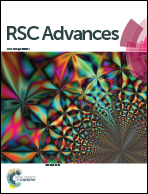CuO nanoparticle catalysed synthesis of 2H-indazoles under ligand free conditions†
Abstract
A CuO nano catalysed one-pot synthesis of 2H-indazoles has been devised from easily accessible starting materials viz. 2-bromobenzaldehydes, primary amines and sodium azide under ligand free conditions. The nano CuO catalyst played an important role during the formation of the intermolecular C–N bond followed by the intramolecular N–N bond, providing 2H-indazoles. This method has a broad substrate scope with a high tolerance of a variety of functional groups. The catalyst can be recycled up to three times, however with slight decreases in the yields each time.


 Please wait while we load your content...
Please wait while we load your content...